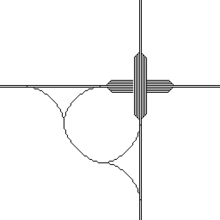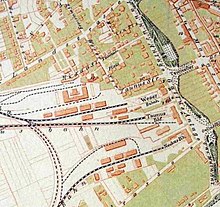Connection curve
In the railway sector, a connecting curve , a connecting line , a connecting arc or a connecting loop is a short stretch of route that, when two railway lines meet or cross, offers trains an additional possibility of transition from one line to the other. The convergence of the routes often takes place inside a station , the connecting curve usually being located outside the station. As a rule, trains using the connecting curve do not pass through the station. In this respect, the connecting curve represents the simplest and most common form of aBypass .
These connecting curves are used, for example, on routes that come together from the same direction in a train station, to avoid a change of direction of the trains in the train station and the associated time-consuming transfer of the locomotive to the other end of the train. At head stations they lead freight trains and other passing trains past the station. In the case of tower stations, connecting curves serve as the transition between the lines that cross without a plan . There are cases in which trains using the connecting curve have to pass through both the upper and the lower part of the station one after the other, only have to pass through one part of the station or neither of the two parts of the station.
Connecting curves have often been built due to changed traffic flows. In many cases, they are or were intended for diversions when route closures. This was particularly true in connection with the destruction of the war. Often they were created as a precautionary measure for strategic reasons, with the aim of avoiding large railway junctions or complex bridges in the event of destruction.
Examples

- The Nantenbacher curve connects the Würzburg – Aschaffenburg railway with the Hanover – Würzburg high-speed line and thus shortens the length of the rail between Aschaffenburg and Würzburg by around ten kilometers.
- For the three railway lines leading to Frankfurt from the west, the Taunus Railway from Wiesbaden (1839), the Main-Neckar Railway from Heidelberg (1846) and the Main-Weser Railway from Kassel (1850), were built on the outskirts of Frankfurt at the time the three adjacent west train stations : the Main-Weser-Bahnhof (1850), the Taunusbahnhof (1839) and the Main-Neckar-Bahnhof (1848). The routes of all three railway companies were connected to each other by a connecting curve west of the respective station facilities until the opening of Frankfurt Central Station .
- In 1933, the former Eutingen turning station was relocated on the Eutingen im Gäu – Freudenstadt railway line and a connecting curve was built, eliminating the need to turn the trains .
- Between the Baden Black Forest Railway and the Württemberg – Stuttgart – Hattingen railway line , a section was opened in 1934 that directly connects Tuttlingen and Hattingen (Baden) and saves trains having to turn around in Immendingen .
- The Berlin curve is a 4.9 km long railway line east of the small town of Bebra in North Hesse . The double-track, electrified connecting curve enables a direct journey from the Halle – Bebra railway coming from Eisenach in a south-westerly direction to the Bebra – Fulda railway .
- The Eichenberger curve enables journeys from Erfurt / Halle to Göttingen – Hanover, although the Halle – Hann. Münden meets Eichenberg station from the north .
- The connecting curve at Abzw Höflein connects the Bamberg – Rottendorf railway with the Bamberg – Hof railway in order to travel from Schweinfurt / Würzburg without changing direction - bypassing Bamberg train station - towards Hallstadt (b Bamberg) (and vice versa).
- The Rosenheim curve was in 1982 by the ÖBB created by which the German Eck traversed trains when changing from frt Rosenheim-Salzburg railway to the railway line Rosenheim-Kufstein border not in Rosenheim contact to have.
- On the connecting curve Weißig-Böhla near Dresden distance and fast freight trains from the will to traffic-related unbundling Leipzig-Dresden railway on the Berlin-Dresden railway out. Long-distance trains continue on the railway line from Leipzig to Dresden after about 13 kilometers, where the two lines cross after a parallel course.
- In Switzerland , the “war loop” between Rothrist and Zofingen was created in 1940 in order to be able to bypass the Olten junction if necessary. Since 2004, after the new Mattstetten-Rothrist Bahn 2000 line was built , this route has also been used by InterCity trains Bern-Lucerne according to schedule .



